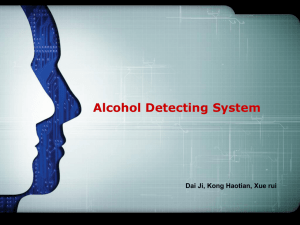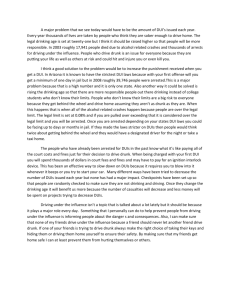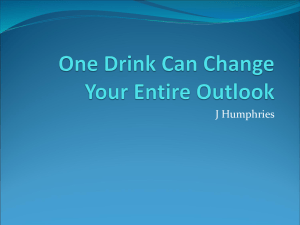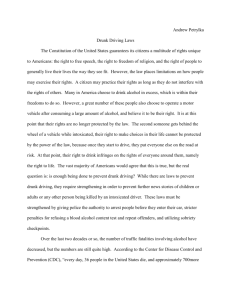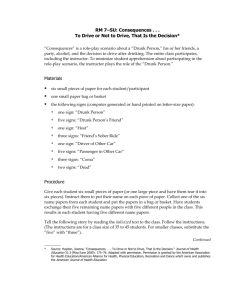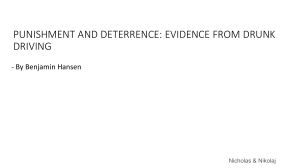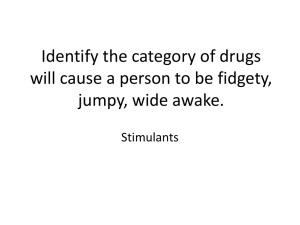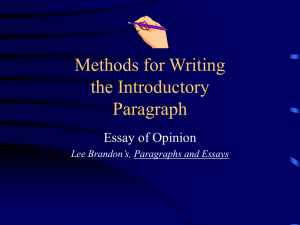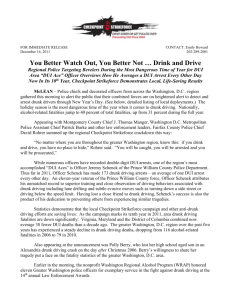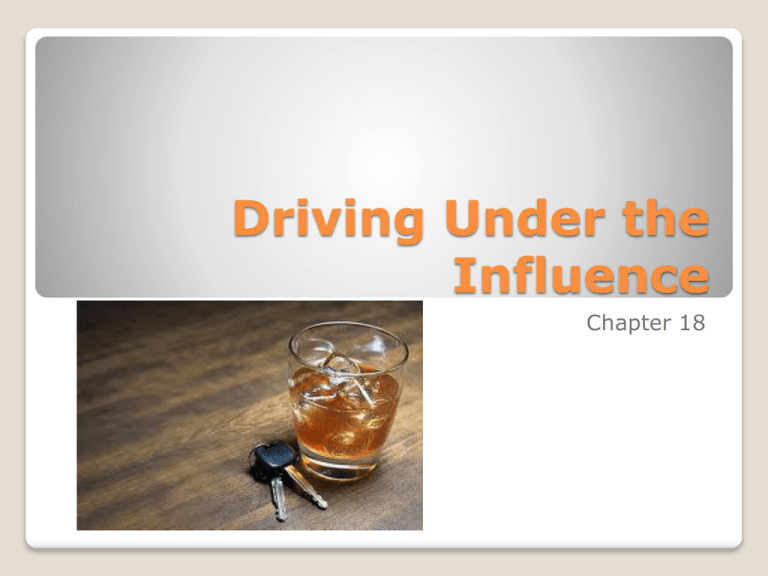
Driving Under the
Influence
Chapter 18
An average drunk driver has driven 80
times before their first arrest
This year, one person every 50 minutes
will die in drunk-driving crashes
1 in 3 people will be involved in an
alcohol-related crash in their lifetime
STATISTICS
Alcohol is the most widely abused drug
Traffic crashes are the leading cause of death
among people younger than 25 years of age,
and more than half of those are alcoholrelated
◦ Most often linked to motor-vehicle collisions
◦ Many are not under the influence themselves
◦ Each year, an estimated 4 million innocent people
are injured or have their vehicles damaged in
drunk-driving crashes
DON’T DRINK & DRIVE!
18-1 Alcohol and Other Drugs
Variety of forms of Alcohol
◦ Beer
◦ Wine
◦ Spirits (whiskey, vodka, rum, tequila)
Concentration of Alcohol
◦ Beer – 3% for light beer, 12% Microbrews
◦ Wine – 12%-14%
◦ Spirits or “Hard Liquor” – 20%-95%
Types of Alcohol
The amount of alcohol in your body at a
given time
Measure of the percent of alcohol in your
bloodstream
◦ For example, if you have a BAC of 0.10%, it
means your bloodstream contains 1% alcohol
Can be measured using chemical test that
analyze breath, blood, or urine
Blood Alcohol Concentration (BAC)
BAC Level
Affect on Body
0.02%
Reactions start to slow and the
first signs of poor judgment appear
0.05%
Driving skills begin to noticeably
deteriorate. Reasoning is less
reliable muscles are too relaxed,
and coordination is decreased
0.08%
Judgment and inhibitions are
affected, as are coordination,
balance, vision, hearing, and
speech
0.10%
All mental and physical skills are
extremely affected. Performing ay
task with your hands or feet,
including walking without
stumbling, is difficult
0.30%
Pass out, coma, or death
1.
2.
3.
4.
5.
6.
The amount of alcohol consumed
The amount of time over which the
alcohol was consumed
The amount of food in your stomach
Your body weight
Whether the alcohol is mixed with a
carbonate beverage
Whether you are a man or a woman
What Determines a Person’s BAC
Liver turns alcohol into oxygen and carbon dioxide through
oxidation
It takes 1 hour to oxidize 1 ounce drink
Some people think you can “sober up” by:
These may make you feel more alert but will not lower
your BAC – only time will!
After some time has passed, you may feel as though you
are good to go – this is a delusion because you are
comparing your peak feeling of impairment with the return
of only some of your physical or mental abilities
◦ Taking a cold shower
◦ Drinking coffee
◦ Exercising
How the Body Gets Rid of Alcohol
Vision
◦ Alcohol relaxes the fine, delicate
muscles that move the eyes and
allow them to focus
◦ Double Vision
An uncontrollable rapid vibration of the
eye that makes it virtually impossible
to see at all
◦ Alcohol distorts your:
Depth perception – stopping distance,
speed of oncoming vehicles
Peripheral vision – tunnel vision
reduces field of vision by 70%
Night vision – impairs vision by 25%
The Physiological Effects of
Alcohol
Physical Reflexes and Coordination
◦ Reaction time is decreased
◦ The brain works less efficiently, and instruction
to muscles are delayed
◦ The effect of alcohol on your muscles is to
decrease coordination
Muscles react more slowly to commands from
your brain and function with less control
Tendency to oversteer, understeer, brake late,
overbrake, or not brake at all
The Physiological Effects of
Alcohol
Decision-making ability is decreased
Inhibitions
◦ Elements of your personality that stop you
from behaving without regard to possible
consequences
Take chances you wouldn’t normally take
Magnify emotions
How Alcohol Affects Judgment
Alcohol is a drug, but what other people think of as
“drugs” can affect the mind and body differently than
alcohol
OTC drugs such as aspirin and other pain relievers,
cold and allergy remedies, and medicines for back
pain and arthritis can cause drowsiness, dizziness,
slower reaction times, reduced coordination
Prescription drugs usually have more powerful effects
on the body, with higher dosages of the same active
ingredients found in OTC drugs
Most OTC and prescription drugs come with warnings
not to drive
Other Drugs
Illegal Drugs
◦ Depressants produce side effects similar to alcohol,
including irritability, confusion, drowsiness, dizziness,
and poor eye-hand coordination
◦ Narcotics can slow reaction time, impair motor skills,
cause dimness of vision. Stimulants make people more
aggressive and overconfident (caffeine & nicotine)
◦ Hallucinogens can make a person confused or unable to
think clearly or concentrated and can have an altered
sense of direction, space, and time
◦ Marijuana can impair ability to see, steer, brake, and
make correct driving decisions. Can cause drowsiness,
fragmented thought patterns, and problems evaluating
spatial relationships and the passage of time
Other Drugs (cont.)
Mixing any drug with another or with
alcohol can lead to serious impairment
◦ Synergistic Effect - The enhancement of a
drug’s side effects caused by mixing it with
alcohol and other certain drugs
When drugs are combined with alcohol, you body
focuses on getting rid of the alcohol first
Because a normal dosage assumes your body will
eliminate part of the drug, the effects of the drug
are multiplied
Other Drugs (cont.)
The best way to prevent driving under the
influence is to prevent people impaired by
alcohol or other drugs from getting on the
road
Everyone at a place or event where there
is alcohol consumed is obligated to take
an active role in keeping drinkers from
driving
18-2 Preventing Drunk Driving
Peer pressure
◦ The influence that others of your own age have
on you
◦ People do things they would never do on their
own to impress friends, classmates, coworkers, or members of the opposite sex
If others decide to act irresponsibly, do
not participate
◦ If they don’t understand, they aren’t real
friends
Resisting Peer Pressure
Ideally, you shouldn’t have any alcohol in your system when driving
◦ If you do drink, consider the factors that can influence your BAC
Most of us have some idea when we have had too much to drink
◦
◦
◦
◦
Speech slurs
Become overly friendly
Voices get louder
Dizziness
Recognize these signs and stop drinking
Listen to your friends if they try to stop you or take your keys
Don’t try to match the drinking of others
If you are afraid to admit you do not want to drink, make up an excuse for not
participating
◦ Anything is better that drinking too much and later causing an injury or death on the
road
Stay active and mingle
Setting Limits On Yourself
Designated driver
Call a friend for a ride
Call a cab
Refuse to be the passenger of a drunk
driver
◦ Offer to drive if you are sober
Stay the night
Alternatives to Drinking and
Driving
Depends on when you drive
◦ Alcohol involvement is 5 times higher at night
than during the day
◦ Risk of colliding with a drunk driver is higher
on weekends, holidays, and vacation periods
Remember that drunk drivers are on the
road at all times
Avoiding Drunk Drivers on the
Road
What to look for
◦ Driving at inconsistent speeds, too fast or too
slow
◦ “Riding” the lane markers on the road or
straddling the center line
◦ Weaving back and forth across the roadway
◦ Drifting into other lanes or opposing traffic
◦ Driving at the edge of the roadway
◦ Driving on or next to the shoulder
◦ Traveling in a turn lane
Avoiding Drunk Drivers on the
Road
What to look for: (cont.)
◦
◦
◦
◦
◦
◦
◦
◦
Braking erratically or stopping without cause
Stopping and starting suddenly
Responding slowly to traffic signals
Tailgaiting
Driving at night without headlights
Passing other vehicles recklessly
Almost hitting another vehicle or object in the road
Leaving turn signals blinking or signaling turns
inconsistently
◦ Making wide or abrupt turns
Avoiding Drunk Drivers on the
Road
Drivers may also exhibit indications of
being drunk
◦
◦
◦
◦
◦
◦
Tightly gripping the steering wheel
Slouching in the seat
Making strange or obscene gestures
Driving with windows open in cold weather
Sticking heads outside the vehicle
Driving with face too close to the windshield
Other Indicators
Keep your distance
Do not try to pass
Or
Pull over to the side of the road
Get the color, make, and model of the
vehicle and direction of travel
◦ Get license plate number if possible
Notify police
Avoiding Drunk Drivers on the
Road
You can be “legally impaired” without ever
having a drink
Technology can prove if you are legally drunk
even if your physical and mental capabilities
appear in perfect working order
You can be charged with a DUI even if your
BAC is well under the legal limit
Police can and do arrest people who they
believe are under the influence of alcohol or
other drugs before they start their cars or
while they are sitting in a parked car
18-3 DUI and the Law
When you are arrested for drunk driving, you
will be charged with either:
◦ Driving under the influence (DUI)
◦ Driving while intoxicated (DWI)
Average offender in Illinois is :
◦ male (78 percent arrested are men);
◦ age 34 (60 percent are under age 35);
◦ arrested between 11 p.m. and 4 a.m. on a
weekend; and
◦ caught driving with a BAC of .16 — twice the illegal
limit.
— Illinois Secretary of State
DUI and DWI
Can be financially devastating
◦
◦
◦
◦
◦
Fines and court costs
Impoundment of vehicle
Attorney’s fees
DUI education programs
Increase insurance premiums
Can be devastating to families as well
◦ Parents may get sued or fined for negligently
supervising your behavior
Can jeopardize employment
DUI Conviction
Any person driving a vehicle has given
consent to have breath, blood, or urine
tested for the presence of alcohol or drugs
By driving a vehicle, you have already
“agreed” beforehand to allow the testing
of your BAC if requested
Implied Consent
Breath Alcohol Test
Field Sobriety Test
◦ Simplest and most common
◦ Breath into a tube and your BAC is measured using infrared
light
◦ On the spot, roadside evaluation
◦ DUI convictions can be based on this alone
◦ Officer will conduct a series of tests that detect physical and
mental impairment
“Horizontal Gaze Nystagmus” test
Divided Attention Impairment tests
◦ Combine mental and physical tasks to be performed at the same time
◦ Walk and Turn - walk a line, heel-to-toe, while counting off your steps
◦ Say the alphabet backwards
◦ Stand on one leg
◦ Close your eyes and touch your nose
Tests for Intoxication
Urine and Blood tests
◦ Blood test is administered by medical
personnel
Potentially the most accurate
◦ Urine tests can be given by the law
enforcement official
Least accurate
Refusal will result in a failed test!
Tests for Intoxication
Can you beat a Breathalyzer test?
Answer: No, there is nothing you can do to
“beat” a breathalyzer test, but there are
things that can affect the outcomes
◦
◦
◦
◦
◦
Breath mints?
Onions?
Denture cream?
Mouthwash?
Pennies?
Mouthwash
Breath spray
Beat the Breathalyzer?
Special roadside safety checks in which
police officers stop drivers to determine
whether any are impaired by drugs or
alcohol
◦ If alcohol is suspected, a field sobriety test will
follow
Sobriety Checkpoints
Makes it illegal to have any kind of open
container of alcohol in a motor vehicle
unless it is kept out of the immediate
control of the occupants, such as in the
trunk
Any alcoholic beverage transported in the
passenger compartment of the vehicle,
including glove box, must be full, sealed,
and unopened
Open Container Laws
Will depend on whether it is your first offense or not
Can lead to these:
Penalties can be enhanced
◦
◦
◦
◦
Revocation of your license
Sentence to perform community service
Installation of an ignition interlock device
Confiscation of your vehicle
◦ Sentence enhancement can occur if:
You were speeding
You refuse a chemical test
If a child under 16 was riding in the vehicle at the time
There is property damage
Injuries or death occurred, can be charged with a felony
◦ Felonies are punishable by a heavy fine, automatic jail term, and extended
probation
Zero Tolerance Laws
Penalties for DUI Convictions

